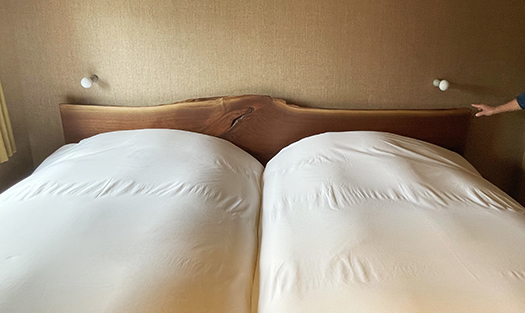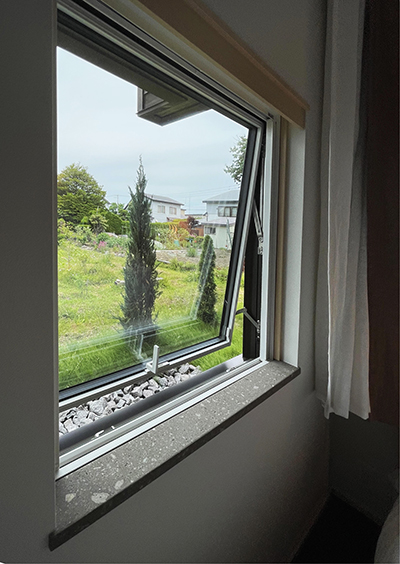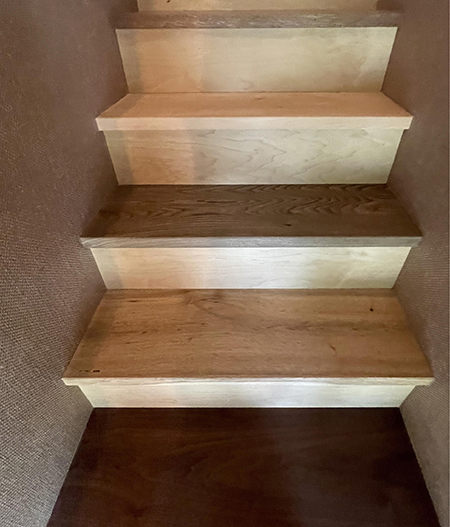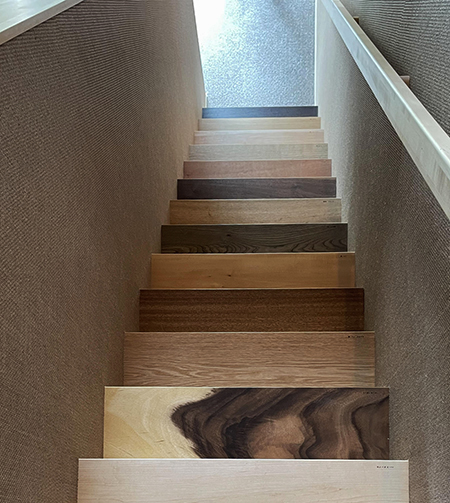



さてコンドミニアム木造建築ということでほぼ同じ間取りの住居空間が3つ、ひとつの建物の中で同居している。そういうことなので、それらのなかからどれかを選ぶときのことを考えたのか、見てくれ上の違いを演出しなければならない必要性があったと想像される。
建築コストとしては当然、最小限に抑えたいので間取り仕分けについては手を触れずに、表面上の軽微な「相違」を目立たせることに決定したようです。使用する建材のサイズや形状は変更することなく、違いを浮き立たせるのに仕上げ素材を各戸ごとに変化させていた。
上の写真はベッドの背板に自然の建材を使って「やすらぎ感」を演出したモノ。ベッドの背板でこういう木目が強調された面材は、機能性とも調和していてなかなかに好感。わが家でも天然木のナラの自然乾燥材を5-6年放置後にテーブルとして使っていますが、自然の木目は「同じものはふたつとない」ので、見飽きることがない。毎日使うモノだからこそ素材感が生きてくると思う。
ベッドは1日のおわり、はじめにいちばん目に飛び込んでくるので、そういった自然造形利用には合点がいくと思われました。
2番目は窓の下枠に軟石を使ったもの。こちらは窓サッシ本体とは縁の切れた枠なので、建材選択の自由度があるということでしょう。軟石もまた、大自然の火山活動の結果生成されるものなので、一期一会の素材造形が表情に表れてくる。わが家でもコンクリートブロックの本体壁面と調和させるように玄関の外部ステップに採用している。かすりにも似た風合いが目に飛び込んで印象に変化が出る。
そして3番目には階段の踏み板が各段ごとに色合いを変えて張り込まれていた。これについては特に、きのう触れた「高齢者住宅」要件としてアリなのではと思われた次第。というのは、実際的に高齢者の生活上の最大の問題は「認知機能の衰え」なのだと思うのです。最新の脳科学などの専門家ではないので解析はできませんが、このように足下がカラフルに変化しているのは、常に注意力が足下に向かっていくように思われて、実効性があるように思えるのですね。
そういえば高齢になれば若い人と同じようにカラフルで刺激的なデザインの服を着た方がいい、とよく言われる。あれはそうすることによって認知機能を再生・維持させようという自然な人間の知恵なのではないかと思っています。加齢しても考え方は積極的になっていく仕掛けとして機能するのではないかと思われてならない。
最近メディアなどで活躍されている脳科学者の中野信子先生の服装センスも、どっちかといえば派手めでちょっと濃厚系の印象を受ける。たぶん無意識なのでしょうが、脳の働きを活性化させることと、表皮的な部分へのセンスというのには相関性があるのかも知れない。
高齢になったら、服装だけではなく室内インテリアでもそこういった志向性に強い意味があるように思われてなりません。
English version⬇
[Senior Citizen Housing and Fancy Material Selection 2room x 6room Condo – 4
It is said that fancy clothes are good for the elderly in terms of reducing cognitive decline, but isn’t that also probable in residential interiors? …
Now, as this is a condominium wooden building, there are three living spaces with almost identical layouts living together in a single building. Therefore, it is assumed that there was a need to create a visual difference in order to make people choose one of them from the others.
As for the construction cost, they naturally wanted to minimize it, so they decided not to touch the floor plan sorting, but to make the minor “differences” on the surface stand out. The size and shape of the building materials used were not changed, but the finishing materials were varied for each unit to highlight the differences.
The photo above shows a bed backboard that uses natural building materials to create a sense of “yasuragi” (relaxation). This kind of surface material that emphasizes the grain of the wood on the back of the bed is in harmony with the functionality of the room and is quite pleasing. In our home, we use naturally dried oak wood as a table after 5-6 years of use, and the natural grain of the wood is never boring to look at because “no two pieces are the same. I think the texture of the material comes alive precisely because it is something we use every day.
The bed is the first thing you see at the end of the day, so I thought it would make sense to use this kind of natural form.
The second is the use of soft stone for the lower frame of the window. Since this frame is disconnected from the window sash itself, there is more freedom in the choice of building materials. Since soft stone is also produced as a result of volcanic activity in nature, it is a material that is formed in a unique way each and every time it is used. In our house, it is also used for the exterior steps of the entrance to harmonize with the main wall of concrete blocks. The texture, similar to that of the graffiti, catches the eye and gives a different impression.
Thirdly, the stair treads are covered with different colors for each step. This was especially interesting to me as a requirement for “senior citizen housing,” which I mentioned yesterday. In reality, the biggest problem in the lives of the elderly is the decline of cognitive functions. I am not an expert in the latest brain science, etc., so I cannot analyze it, but it seems to me that this kind of colorful change underfoot is effective because it seems that attention is always directed toward the feet.
Come to think of it, people often say that when you get older, you should wear clothes with colorful and stimulating designs just like younger people. I believe that this is natural human wisdom to regenerate and maintain cognitive functions by doing so. I cannot help but think that it may function as a mechanism to make our thinking become more active even as we age.
The brain scientist Dr. Nobuko Nakano, who has been active in the media recently, also gives me the impression that her sense of dress is rather flamboyant and a bit thick-skinned. Perhaps unconsciously, there may be a correlation between the activation of brain function and a sense of style in the epidermis.
It seems to me that when one gets older, there is a strong significance to this kind of orientation not only in one’s clothing but also in one’s interior design.
Posted on 7月 2nd, 2023 by 三木 奎吾
Filed under: 住宅取材&ウラ話







コメントを投稿
「※誹謗中傷や、悪意のある書き込み、営利目的などのコメントを防ぐために、投稿された全てのコメントは一時的に保留されますのでご了承ください。」
You must be logged in to post a comment.